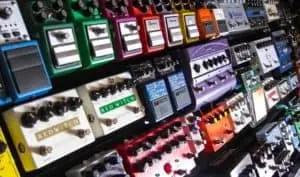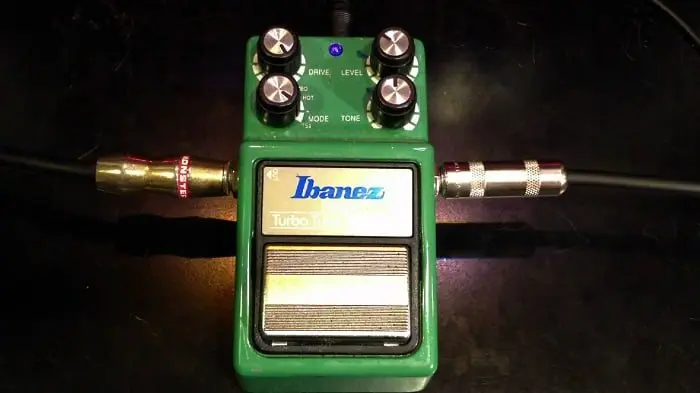 Just how big of an impact guitar pedals in general had on music in past decades is hard to fully describe. Every new type of pedal that appeared expanded the existing sound with a whole new dimension.
Just how big of an impact guitar pedals in general had on music in past decades is hard to fully describe. Every new type of pedal that appeared expanded the existing sound with a whole new dimension.
Now let’s go one step deeper and say that every model of every type of pedal had its own little twist. How each of these pedals reacted with one another multiplied the type of sound musicians could create to a ridiculous amount.
Naturally, some pedals were more popular than others, while few were so loved they reached a legendary status. Today we will try to name some of the most popular guitar pedals in history.
With so many influential models to name, forgive us if our exact choice doesn’t align with your own opinion. We will include both overdrive/distortion pedals, as well as effects pedals.
Without further ado, let’s dive right in.
– Ibanez TS9 Tube Screamer
While it wasn’t the first overdrive pedal, it is probably the most influential one ever made. Ibanez TS9 Tube Screamer was an evolution of the existing TS808, and it greatly improved the performance of an already good platform.
[su_youtube url=”https://www.youtube.com/watch?v=Lazd3Xplwsw”]
For a pedal first released in ’82, TS9 Tube Screamer is still being sold to this day, although as a reissue. This pedal was used by numerous legendary artists, no matter the music genre. From Steve Ray Vaughn, to Metallica, TS9 can be heard on some of the most iconic albums in history of music.
– Electro-Harmonix Big Muff PI
Today there are many great distortion pedals available, but back in the ’70s that wasn’t the case. One pedal stood out back then while quickly becoming the choice of artists such as Santana and David Gilmour.
[su_youtube url=”https://www.youtube.com/watch?v=BXAVvH4Ra60″]
Electro-Harmonix Big Muff Pi offered a uniquely saturated distortion full of grit right off the bat, only enriching the already great deal by bringing up the bass for a wholesome sound. Having a distortion like that while retaining note definition was no small feat. Heck, it’s no small feat even today.
– Dunlop Cry Baby Wah
Dunlop’s Cry Baby Wah was a pedal which Jim Dunlop produced since the 1983. It was originally produced by Thomas Organ Company, a somewhat obscure enterprise which used to import and distribute Vox products back when they had no presence in United States.
[su_youtube url=”https://www.youtube.com/watch?v=Q7h5k3A0GhI”]
Thomas first started making these in the ’60s, but eventually halted all production in early ’80s. When Dunlop started making the Cry Baby Wah, it wasn’t the only wah pedal on the market but it was the most unique one, and it remains so to this day.
– MXR Phase 90
MXR Phase 90 is a very different type of phase-shifter compared to ones you being made today. Unlike those, MXR Phase 90 never stood out that much, forming a very natural bond with the tone of the guitar.
[su_youtube url=”https://www.youtube.com/watch?v=OJfFt2i2Yd4″]
Musicians such as Eddie Van Halen simply loved it for its subtle approach, and the fact that it improved the treble to a certain extent. One could say that hi considered it an important tool in his arsenal.
– MXR Dyna Comp
First appearing in ’75, Dyna Comp by MXR was one of the more rugged and capable compressors on the market. It wasn’t too versatile, nor did it offer too many features, but the finesse it brought to the table made it a must-have element of any pedalboard.
[su_youtube url=”https://www.youtube.com/watch?v=_h9uMjUc-Zw”]
MXR Dyna Comp brings every subtle detail to the foreground, while also allowing you to hear the low-end descent just fine. The fact that there’s many of these as much as 30 years old, which are still in circulation is a testament to the build quality MXR delivered back in the day.
– Boss CE-1 Chorus Ensemble
When Boss released the CE-1 Chorus Ensemble in 1976, it spread through the guitar world like fire. Chorus was not an effect you could hear too often in those years, but CE-1 changed that for good. Before the decade was over, almost every famous guitar player used it in their music.
[su_youtube url=”https://www.youtube.com/watch?v=mU6mzcCKR1k”]
You could go so far as to say that this pedal single handedly transformed the sound of late ’70s and early ’80s rock scene. Not everyone will agree, but it definitely made the Chorus effect a mainstream asset.
– Electro-Harmonix Deluxe Memory Man
In today’s day and age, something like an analog delay pedal would be considered primitive and outdated by most people. However the Electro-Harmonix Deluxe Memory.
[su_youtube url=”https://www.youtube.com/watch?v=_eCvr0OnNYE”]
Man produced such a unique and charming low tech effect that many guitar players still prefer it to this day. Sure, it’s outperformed by just about any decent delay pedal available today, but you just can’t reproduce the sound this thing creates.
– MXR Six Band Graphic EQ
This spartan EQ pedal may not seem like much on the first glace, especially since it doesn’t even have an on/off switch, but it was one of the most important parts of many great guitar player’s pedal boards.
[su_youtube url=”https://www.youtube.com/watch?v=AxJkNZlX05o”]
Dimebag Darrell really loved the MSR Six Band Graphic EQ as it gave him the ability to bring up those mids, which were a pretty important part of Pantera’s sound.
– Pro Co Rat
Another distortion pedal that impacted the whole scene in the late ’70s was the now famous Pro Co Rat. It just offered a different type of distortion that gave people like Jeff Beck more maneuvering space to shape their sound.
[su_youtube url=”https://www.youtube.com/watch?v=NlF3MjlT6_c”]
It’s fair to say that most of ’80s hair metal wouldn’t sound the same if it wasn’t for the Pro Co Rat.
In summary..
 These are just some of the most popular guitar pedals that left their mark on the history of music. Unfortunately there are too many to fit into a single article and still do them some justice.
These are just some of the most popular guitar pedals that left their mark on the history of music. Unfortunately there are too many to fit into a single article and still do them some justice.
Some of these pedals are all but extinct today, while others have returned in form of a reissue. Pedals such as the TS9 Tube Screamer have been in service for over 30 years, and are still relevant no matter how much the technology has advanced. This just goes to show that some things are timeless.
